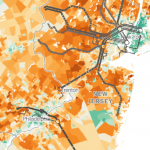New Jersey Future Blog
New CDBG Action Plan Amendment Considers Resiliency
February 4th, 2014 by Chris Sturm
Critical Improvements Still Needed
 The newly released Substantial Amendment for the Second Allocation of CDBG-DR funds, intended to guide the disbursement of $1.46 billion in Sandy recovery assistance, represents a step forward in both resiliency language and public involvement, but misses key steps needed to ensure taxpayer dollars are wisely spent to make New Jersey “Stronger than the Storm”.
The newly released Substantial Amendment for the Second Allocation of CDBG-DR funds, intended to guide the disbursement of $1.46 billion in Sandy recovery assistance, represents a step forward in both resiliency language and public involvement, but misses key steps needed to ensure taxpayer dollars are wisely spent to make New Jersey “Stronger than the Storm”.
“New Jersey Future congratulates the Christie administration on its positive steps in public outreach and discussing the importance of forward-looking planning,” said Peter Kasabach, executive director. “We call on the administration to make these steps even more meaningful by sharing data used to allocate federal funds and establishing more detailed future-oriented risk criteria that ensures residents and businesses are not put back in harm’s way.”
The plan calls for three public hearings, two more than the minimum required. These hearings represent a significant improvement in efforts to engage the public, particularly those most affected by Superstorm Sandy, in the allocation of these critical funds.
However, the plan continues an unfortunate trend of underfunding infrastructure including transportation, water and energy. It allocates $535 million for infrastructure projects, representing 18 percent of total CDBG-DR funding, a fraction of the plan’s assessment of unmet infrastructure needs, which totals 90 percent of all unmet needs.
Notably, the Christie administration acknowledges the need to consider future risks, including sea level rise, in infrastructure decision-making. The plan applies this new federal requirement for risk assessment to one category of infrastructure project – the Flood Hazard Risk Reduction and Resiliency Measures. The plan also pledges to incorporate this analysis as it updates the state Hazard Mitigation Plan.
The state’s commitment to factoring a forward-looking risk analysis into its decision-making should extend beyond the narrowly defined federal requirements, and across all post-Sandy rebuilding efforts including local planning, residential rebuilding and buyout programs. Additionally, the state should strengthen its requirements for how the forward looking risk analysis will be considered during infrastructure project review, and require any cost-benefit analysis to consider risks over the total lifespan of the project. Adoption of the action plan should be held until the state can offer detailed criteria for the Flood Hazard Risk Reduction and Resiliency Measures for public review and comment.
The plan dedicates another $5 million for community planning, funding that is sorely needed. However, this plus the $5 million from the first allocation represent less than one-third of 1 percent of total CDBG-DR spending. To meet communities’s rebuilding needs, the planning allocation should be at least an additional $12 million to: 1) fund grant recipients to perform a vulnerability assessment that includes sea-level rise; 2) cover the costs for communities to participate in FEMA’s Community Rating System, which lowers both municipal and homeowner flood insurance costs; 3) reach Sandy-affected municipalities in Cumberland County; and 4) provide adequate funds for local recovery management services to help municipal staff develop and implement recovery plans.
The plan makes provision for up to $5 million in larger regional or statewide planning initiatives, and mentions in particular a proposed project called VisualNJ, which would aggregate all the vulnerability mapping work currently being done by private and university entities. The plan should require that all criteria for statewide or regional initiatives eligible for this $5 million be made public, as should access to the VisualNJ project, should it move forward.
New Jersey Future’s experience having placed local recovery planning managers in seven severely-affected municipalities indicates that many smaller municipalities lack the resources to execute good long-term planning, and it is encouraging to note that the funds allocated to Essential Government Services may be used for planning.
Finally, the plan needs to require greater transparency than is currently mandated, including the data noted above, as well as:
- the state’s “15 year review of FEMA public assistance data” used “to identify with greater precision those areas of the State that routinely experience loss from repetitive flooding”
- project list for infrastructure projects to be funded by the non-federal cost-share program;
- the cost-benefit formulas, including timelines, that will be used to prioritize infrastructure projects;
- the geography of unmet need, to show where problems exist. Such an analysis would help ensure that housing funds, buyouts, and other rebuilding assistance be targeted to the most vulnerable locations.
- the work being done by the university consortium, none of which has been made publicly available statewide.
“The draft Action Plan amendment provides the framework to address these concerns,” said senior director of state policy Chris Sturm. “The Christie administration can and should revise it before adoption to ensure that the public’s investment in rebuilding makes New Jersey safer and stronger. “
Action plan, amendments and related documents. This plan is labeled as Amendment 7.
















